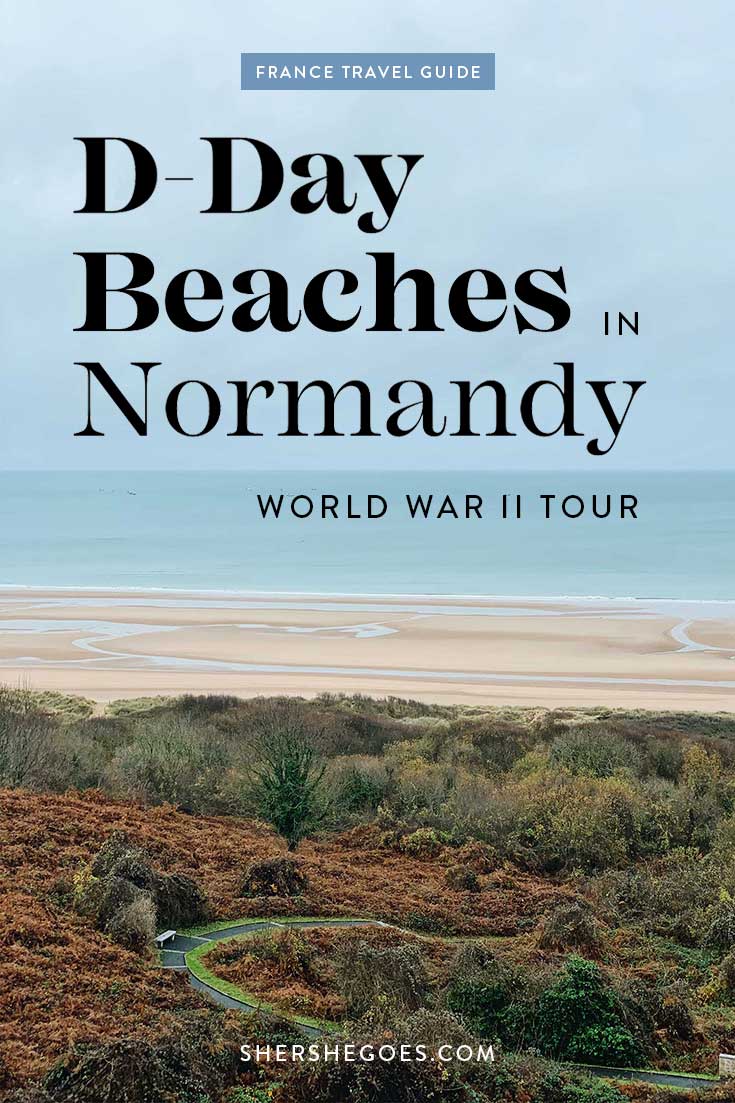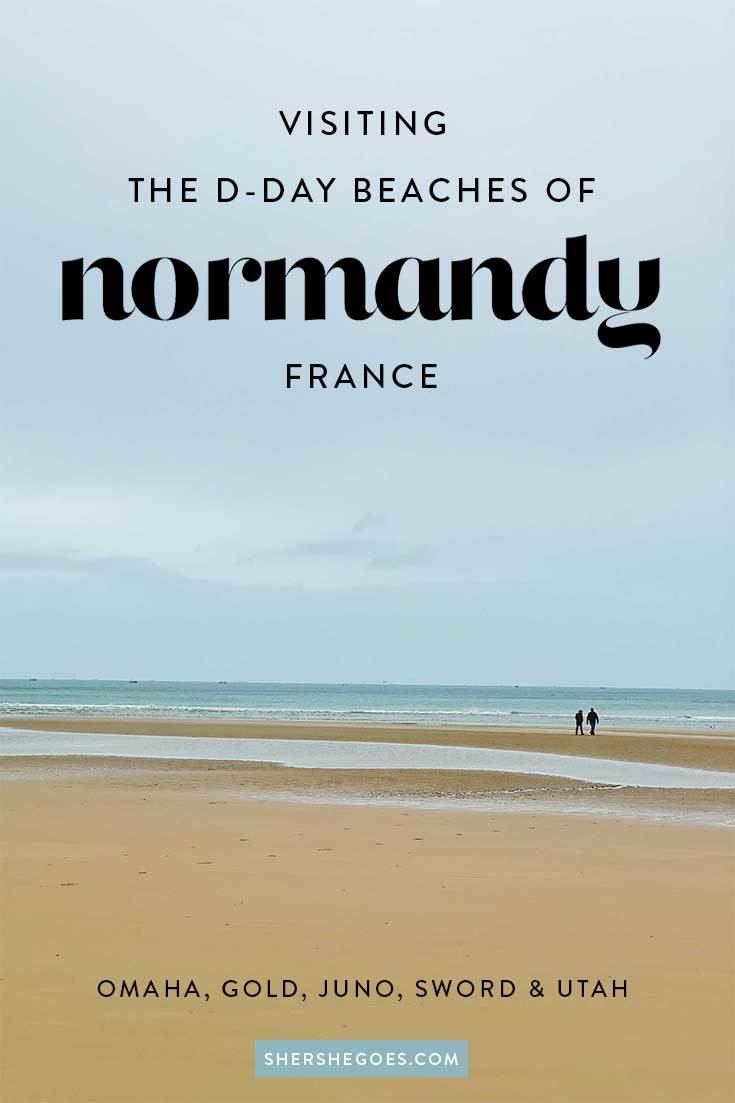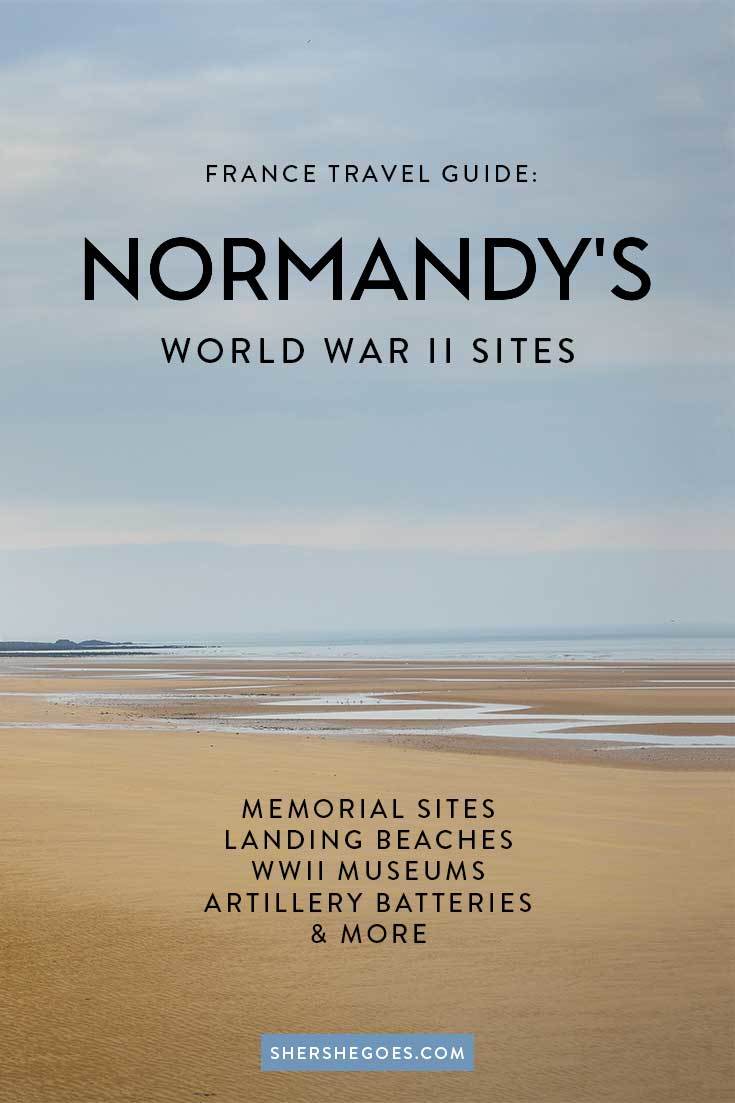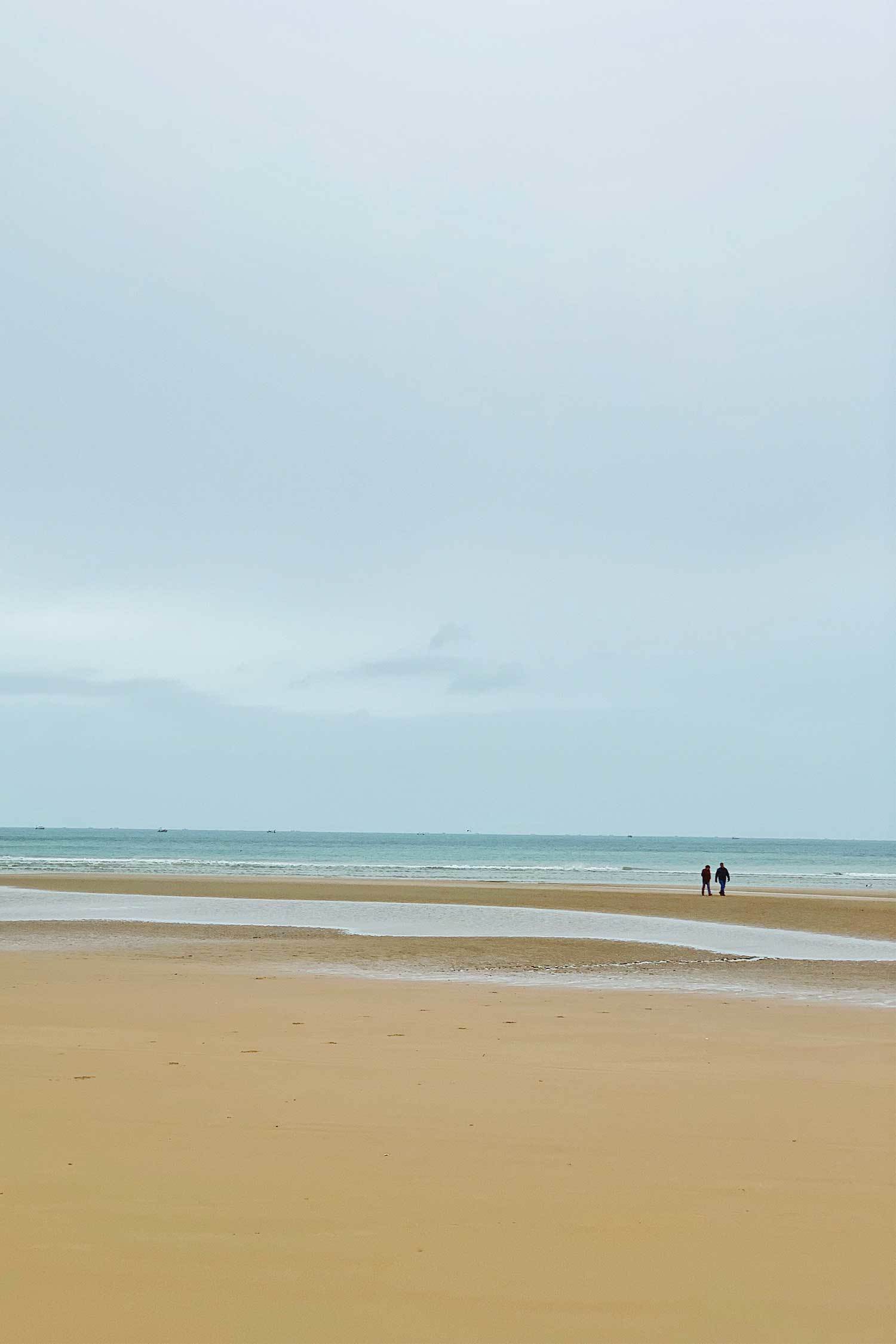Normandy Beach
On our river cruise along the Seine, we took a detour to see the Normandy beaches.
This is the second time I’ve been to France’s northern region but I don’t quite remember any of the history from the first trip. I was a student at the time, and our school trip connected us to a French World War II war veteran who met us directly on the sandy beach of Omaha.
This time, I’m older and learned the history of D-Day in depth.
ADVERTISEMENT
As the landing beaches are a bit far from Rouen, where we’re staying the night, our tour guide uses the the 4 hour bus ride (2 there, 2 back), to recount the careful planning, hellish slaughter, entrenched fighting and ultimate resolution of Operation Overlord (the Allies code name for the invasion of Normandy).
It’s a sobering visit.
Before World War II, Omaha Beach was called La Plage de Sables D’or, the Beach of the Golden Sands. No one has called it that in years. Each Normandy beach retains its D-Day code name, in remembrance of the significance of the world’s largest amphibious invasion, which kick started the long campaign to liberate Europe.
Here’s a look at each of the five landing beaches and some tips for visiting Normandy’s World War II memorials.
Or save this article to read later by pinning it ⇟



ADVERTISEMENT



Why Did the Allies Land on the Beaches of Normandy?
After the massive British retreat at Dunkirk (immortalized in the film Dunkirk), the Allies had temporarily withdrawn from Europe to regroup.
By the time the Americans joined the war effort, with Russia pressing on the eastern front, it was decided to begin planning an western invasion.
The gargantuan task of liberating Europe was code named Operation Overlord. D-Day would be the initial push, a massive amphibious landing to place the Allied forces in continental Europe and begin fighting for the liberation of France.
ADVERTISEMENT
The invasion took significant planning, and began as early as 1943. Since Germany occupied or destroyed all of France’s main ports, the Allies had to strategically choose a landing site.
Pas de Calais, roughly 150 miles northeast of Normandy, was the most logical choice, as it was the closest point to England and the shortest distance from the British Channel.
Unfortunately, the Nazis recognized this and heavily fortified the area.
After careful consideration, the Allies chose Normandy to be the site of the landing beaches. To disguise their efforts, they undertook an elaborate ruse to trick the Nazis into concentrating at Pas de Calais and keep them off guard.
However, the Germans did not leave Normandy entirely undefended. Hitler put one of his most competent generals, Erwin Rommel, in charge of defending the French coast.
Read more: The Best Things to Do in Normandy, France
ADVERTISEMENT
D-Day
American General Dwight Eisenhower was put in charge of planning for Operation Overlord, with British General Bernard Montgomery to take over once the landings were successful.
The task was daunting, as General Rommel had prepared by ordering Nazi troops to turn Normandy’s coastline into a death trap: beach obstacles, land mines, artillery batteries and barbed wire were all laid across the countryside.
For D-Day, the Allies divided the 60 mile coastline into five sectors, code named from west to east: Utah, Omaha, Gold, Juno and Sword. The Americans were to land primarily on the western fronts at Utah and Omaha, while the British were tasked with capturing the eastern beaches, Gold and Sword. The Canadian forces were to lead at Juno.
In addition to the amphibious landings, an extensive aerial bombardment was planned. In total, roughly 160,000 troops landed on the Normandy Beaches on June 6, 1944 and 11,000 planes and 4,000 ships were used in the attack.
While today D-Day is considered a great success in the greater context of World War II, the day itself was a mixed bag. Some beaches were captured relatively easily while others were entrenched in long, bloody battles with devastating casualties.
The Allied goal was to secure all five beaches and link its forces together by the end of the day. While each force secured their respective beaches, heavy German resistance delayed a unification until June 12th.
Read more: Here are the Prettiest Towns in Normandy
ADVERTISEMENT
Visiting the D-Day Beaches
The D Day beaches are spread out throughout Normandy’s coastline and can be seen in a day in one comprehensive tour. There are over 20 important monuments, museums and military remnants in the region, but perhaps the most visited site is Omaha Beach, as it was here that the fighting was the bloodiest.
The Americans were assigned to Omaha Beach and today, the Normandy American cemetery overlooks the beachfront, with a haunting memorial, visitor’s center and excellent museum.
For those planning to visit, it’s a great idea to book a local tour, as they can give you a much more comprehensive overview of the military planning, battles, and key events that occurred. Normandy is notoriously rainy all year round, so pack layers, a weatherproof jacket and umbrella.
If you’re visiting in June, Normandy marks the remembrance of D-Day with a number of ceremonies and reenactment groups. The French people in Calvados remember the significance of D-Day and always celebrate the anniversary of France’s liberation.
ADVERTISEMENT
Hotels in Normandy Near the D Day Beaches
Most visitors choose to base themselves in either Caen or Bayeux, the two closest French villages to the Normandy beaches.
Caen, a large city in the department of Manche, is roughly 10 miles from the coastline. The modern city has lots of hotels, shops and restaurants and plenty of car rental agencies for visitors who wish to drive around. Find hotel deals for Caen here.
Bayeux is smaller and more historic, as it was spared bombing during WWII. Most D Day tours pick up from Bayeux so this village makes a great base for those who wish to take advantage of a guided tour. Find hotel deals for Bayeux here.
Both Bayeux and Caen have train stations with connections to Paris. But Normandy has plenty of other villages, some even prettier, that are closer to the D-Day beaches. These include:
Ouistreham-Riva-Bella: This resort town lies closest to Sword Beach and has a ferry with connection to Portsmouth. The assault on Ouistreham was immortalized in the movie The Longest Day.
Arromanches-les-Bains: Near Gold Beach, this is where the Allies built portable Mulberry harbors. Since the Nazi powers controlled or destroyed all of France’s harbors, the Allies needed to construct their own ports from scratch, as quickly as possible. The town here is quaint and has a charming museum explaining all about the famous Mulberry harbours.
Sainte-Mère-Église: Inland of Utah Beach on the west, this town played a significant role in the Normandy landings as it stood in the middle of route N13, the main road to Utah and Omaha beaches. American paratroopers landed early on D-Day before the seaborne invasion, to heavy casualties.
For more travel tips about visiting the landing beaches, check out our travel guide covering transportation from Paris to Normandy here.
ADVERTISEMENT
Getting Around
Unfortunately, public transportation in Normandy is limited.
Renting a car offers the most flexibility and can be pretty inexpensive for families and groups. American drivers licenses are accepted and you can easily find car rental shops in the cities of Rouen, Le Havre and Caen.
Taking a guided tour is a great option for those who don’t want to drive. Most tours cover the beaches, museums and cemeteries in a full day excursion, and include knowledgeable local guides. The most popular tour companies pick up and drop off from hotels in the town of Bayeux.
Finally, you can also take a river cruise. Normandy is where the Seine River begins and many river cruise companies offer trips from Paris to Normandy. We recently took a Viking cruise and loved it.
ADVERTISEMENT
Should You Get A Guide?
We definitely recommend a guide. The D-Day beaches and memorial sites are spread out over a vast area, and many of the town roads are small and winding. Knowledgeable tour companies can cover more ground in a day (without getting lost!) and offer insightful history and local memories that really bring D-Day alive.
On the tour we took, we visited the floating harbor at Arromanche, the museum at Caen, the American cemetery and Omaha Beach.
Here are some popular D Day tours
ADVERTISEMENT
D Day Beaches Map
Above is a map of the D Day beaches that illustrates the extensiveness of Operation Overlord.
Over 50 miles of Normandy coastline are marked with war memorials, old military bunkers and D-Day monuments. Two departments in Normandy, Calvados and Manche, experienced the brunt of the fighting, with hundreds of French village getting swept up in the fighting.
The 5 Beaches of D Day
The Allies divided Normandy’s coastline into 5 beaches. With over 50 miles of coastline to cover, it was a significant expanse of land! From west to east, the beaches are:
First time visitors can start in Caen, at the Memorial Museum; at Arromanches, where temporary harbors were built in advance of the invasion; or at Bayeux, where the historic Bayeux Tapestry is housed.
ADVERTISEMENT
The Landing Beaches
Today, the five beaches where the Allies landed are still referred to by their D-Day code names. Allied forces divided up the beaches by country, with predominantly British, Canadian and American forces leading the assault.
Below is a short overview of each beach and their respective WWII sights that you can visit today.
Utah Beach
Utah lies on Normandy’s Cotentin Peninsula, and was the westernmost landing site of all five beaches. Allied commanders added Utah as a last minute addition, so that troops would be close to the port city of Cherbourg.
The night before D-Day, thousands of American paratroopers were dropped inland behind enemy lines, in an effort to capture the beach’s exit points and eliminate German defenses.
Unfortunately, strong winds dropped the paratroopers significantly off course and the region’s wet marshes made it difficult for the troops to make it to the beaches quickly. Many paratroopers got caught in tree branches and were picked off easily. One man’s parachute landed on the church steeple of Ste Mere Eglise village!
On D-Day, strong currents also swept the bulk of American troops off course. Luckily, they landed at a more lightly defended section of the beach and met little resistence, securing Utah Beach by the end of the day.
WWII memorial sights at Utah beach include:
- The Airborne Museum
- D-Day Experience Center
- Utah Beach Landing Museum
- Ste-Mère Eglise Village
ADVERTISEMENT
Omaha Beach
Omaha Beach was the second landing site for American troops. Surrounded by steep cliffs and heavily fortified by an experienced Nazi division, Omaha saw more casualties than any other beach.
The Allies had planned aerial bombardments on each beach, to hit the German’s defenses and provide cover for sea invasion. Timing was of the utmost importance. Strike too early, and the Nazis would have time to regroup while cherry picking off the landing troops. Strike too late, and risk hitting their own forces.
Unfortunately, the aerial bombardments did little damage, the Allies underestimated the number of German forces, and the rough waves made it almost impossible for troops to land. Only 2 of the Allies’ 29 Sherman tanks reached the shore. Carnage was so severe that Omaha was nicknamed ‘Bloody Omaha’.
By the end of the day, the Americans suffered significant casualties but had carved out a tenuous hold roughly a mile and a half inland.
WWII memorial sights at Omaha beach include:
- Pointe du Hoc Ranger Monument
- The Normandy American Cemetery
- Overlord Museum
- Omaha Memorial Museum
- Longues-sur-Mer Gun Battery
- German Military Cemetery at La Cambe
ADVERTISEMENT
Gold Beach
The British were sent to Gold Beach, with objectives to capture Bayeux and the road connecting Bayeux and Caen, and the eventual aim of linking up to the Americans west at Omaha.
Here, aerial bombardments succeeded in softening the German defenses and strong British warships were able to successfully target the Nazi forces.
By the end of the day, the British had secured the beach, advanced 6 miles inland and joined the Canadian troops in the east who had landed at Juno Beach.
WWII memorial sights at Gold beach include:
- Ver-sur-Mer, Musée America-Gold Beach
- Arromanches
ADVERTISEMENT
Juno Beach
The Canadians were sent to secure Juno Beach and tasked with linking up to the British on both east and west, at Gold and Sword beaches, respectively.
The Germans had planted mines and beach obstacles into the sand along Normandy’s coast. For a brief period during low tide the defensive traps were exposed, but primarily they lay covered, hidden traps to delay any offensive approach.
On D-Day, the Canadians sent to Juno Beach were also hit hard by rough currents, which delayed the ships from landing. When they did land, the rising tide not only masked mines and booby traps, it also shortened the width of the beach and led to a build up of troops and incoming equipment. As a result, the Germans were easily able to pick off the first wave of infantry and Canadian casualties were high.
By the end of the day, after fierce fighting, the Canadians were able to penetrate 16km inland. They linked up with the British at Gold Beach but not those at Sword until later on in the invasion.
WWII memorial sights at Juno beach include:
- The Juno Beach Centre
ADVERTISEMENT
Sword Beach
While the American paratroopers were being dropped behind enemy lines in Utah, British airborne troops were being sent to the eastern flank, behind Sword beach’s German forces.
Here, the British succeeded in destroying bridges to cut off potential German reinforcements, captured Pegasus Bridge and also took out a Germany artillery battery.
By the morning of June 6th, the British sea invasion launched and again suffered losses due to rising tides, delayed landings and shortened beachfront. Eventually, the Allies were able to use Sherman tanks to secure the beach.
The primary objective however, was not met. Sword Beach was chosen for its proximity to the strategically important city of Caen, which was connected to several canals and rivers in Normandy.
German forces entrenched themselves in the city and the Battle for Caen began. The city was ultimately liberated on June 19th, but suffered heavy bombing and significant civilian casualties.
WWII memorial sights at Sword beach include:
- Musée du Mur de l’Atlantique Le Bunker
- Musée du No.4 Commando
- Merville Battery
ADVERTISEMENT
Will you be visiting the Normandy beaches?
Visiting Normandy – Travel Checklist
We took a red eye to Paris from JFK, then sailed on the Seine to Rouen on a river cruise. You can check for flight deals here and set an alert for your dates.
It's also easy to take the train from Paris to cities throughout Normandy. Check my post here for more logistical information on taking the train in France and how not to buy tickets.
In Normandy, there's so much to see over a large area that I'd recommend basing yourself in a city for a couple nights to take day trips, then moving to another city. For the D Day beaches, Bayeux and Caen are both popular bases. Check here for deals on Normandy hotels.
Lastly, be sure to visit Paris with travel insurance. Whether you get injured and need to be hospitalized, your phone gets stolen, or a flight delay leaves you with nothing but the clothes on your back, travel insurance will help when you need it most.
During our recent trip, riots in Paris shut down the city center and forced a closure of all the main sights (the Louvre, Versailles, etc). Get a quote for your trip here.
You Might Also Enjoy:
Normandy Vacation Planning
How to Get from Paris to Normandy
Cruising on the Seine River from Paris to Rouen
The Most Beautiful Places in Normandy
21 of the Best Things to Do in Normandy
Normandy Towns
Quick Guide to Rouen, Normandy's Capital
Paris to Normandy Day Trips: Vernon & Auvers-sur-Oise
Visiting Giverny & Monet's House
WWII Memorials
How to See Normandy Beach & D-Day Sites
Visiting the Normandy Cemetery in Remembrance of D-Day
Follow me @Sher She Goes on









Will be taking Viking Cruise in 2020 that stops in Paris. Want to visit Normandy. Looking for the best way to visit and perhaps stay overnight.
Hi, just came here to say: the Russian front is the eastern front and D-Day is the Western Front. Great article otherwise
Author
oops! thanks for the correction :)